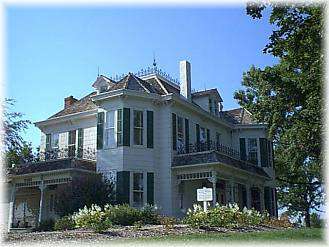Historic Lackman-Thompson Estate
category : Historic Homes
 The promise of opportunity and freedom brought many brave individuals to American shores in the late 1800s, including German immigrants, Margaretha and William Lackman. Their hope: to build the home ... the fortune ... the future of their dreams in a new and exciting land.
The promise of opportunity and freedom brought many brave individuals to American shores in the late 1800s, including German immigrants, Margaretha and William Lackman. Their hope: to build the home ... the fortune ... the future of their dreams in a new and exciting land.The Lackmans found the perfect place to start their new life in the great plains and endless sky of Kansas. When they arrived in 1885, they began construction on an exquisite farmhouse that would showcase the talents of internationally renowned artisans and take more than two years to complete. No expense was spared: This was, after all, a visual statement of their quest for success in the New World.
Best described as a composite of Second Empire and Queen Anne architectural styles, the house featured custom plaster casting, hand-painted ceiling designs, and fine woodcrafting. Italian artisans created ornate ceiling plaster designs, and woodworkers brought in from Germany crafted an extraordinary winding staircase using walnut grown on the Lackman's own land.
Yet, while the Lackmans were building their homestead, they also were instrumental in establishing local trade opportunities north and Olathe to the south. Unfortunately, at the height of this new business venture, two of the Lackman's workers ran off with the $40,000 company bankroll -- causing them to lose not only their share in the railway but, eventually, their prized farmhouse as well. The first chapter in the story of the Historic Lackman-Thompson Estate had come to a close, but not without a hopeful foreshadowing of the new era that was to follow.
In 1908, William Lackman sold his farmhouse, its furnishings, and the surrounding property to Kansas City horse and mule dealer, Frank Thompson. Having been victims of floods in 1903, 1904, and 1908, Thompson, his wife, Carrie, and young son, Hugh, saw the estate much like the Lacmans once did: as a symbol ofhope for the future.
The family prospered in their new home. Because of the railway that William Lackman had helped to create, the Thompsons were able to sell horses and mules all over the country -- to businesses, to the New York Police, and to buyers in the south for work in the cotton fields. During World War I, Frank and Hugh even supplied 1,000 horses to the U.S. Calvary for shipment to France. With their success also came improvements to the estate. The Thompsons were one of the firsts to install their own electric light plant and water well. And, a unique red brick barn with an arched wooden roof was added in 1932 -- designed interestingly, by an architect Thompson had found hitchhiking in the area.
In 1922, Hugh left the estate and married; but, he and his wife, Mary, returned to take over the farm upon Frank's death in 1936. There they raised six children -- another generation of dream builders born ... another chapter written in the story of a rare community legacy.
The home, which contains 2788 square feet of floor space, was listed on the Register of Historic Kansas Places. A joint effort between the City of Lenexa, Johnson County, the State of Kansas and many civic organizations, including the Lenexa Historical Society, restored the home to its original beauty. Today this lovely old home houses the Lenexa Chamber of Commerce, the Lenexa Economic Development Council, and the Convention and Visitors Bureau.
The Lenexa Historical Society conducts tours of the home, by appointment.
Address: 11180 Lackman Road
Phone: 913-492-0038
Come visit us in Lenexa, Kansas
